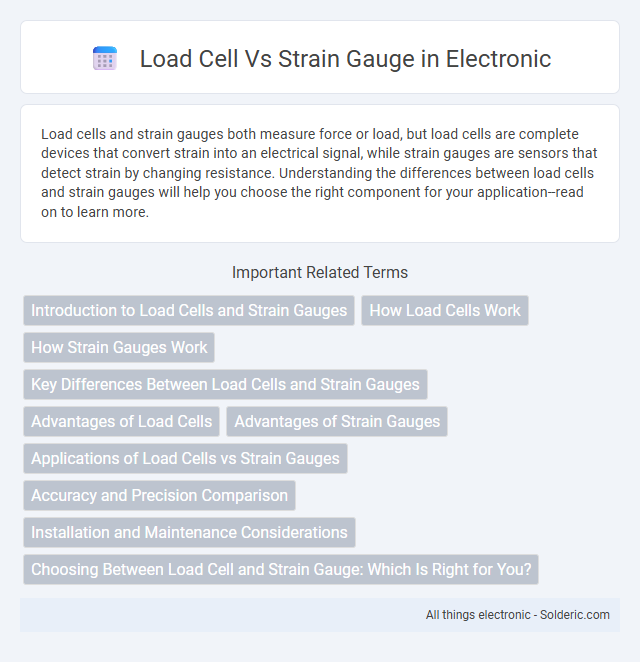Load cells and strain gauges both measure force or load, but load cells are complete devices that convert strain into an electrical signal, while strain gauges are sensors that detect strain by changing resistance. Understanding the differences between load cells and strain gauges will help you choose the right component for your application--read on to learn more.
Comparison Table
| Feature | Load Cell | Strain Gauge |
|---|---|---|
| Definition | Sensor measuring force or load using strain gauges inside | Sensing element detecting strain by resistance change |
| Usage | Direct load/force measurement in industrial applications | Strain detection in materials and structural testing |
| Output | Electrical signal proportional to applied load | Electrical resistance variation proportional to strain |
| Sensitivity | High sensitivity; calibrated for precise force data | Depends on gauge factor; sensitive to microstrains |
| Installation | Pre-mounted, rigid housing; simple to install | Requires bonding to surface; delicate installation |
| Cost | Higher; includes housing and signal conditioning | Lower; only the sensor element cost |
| Applications | Weighing scales, force testing, robotics, aerospace | Material testing, stress analysis, structural monitoring |
Introduction to Load Cells and Strain Gauges
Load cells are transducers that convert force or weight into an electrical signal, utilizing strain gauges as their primary sensing element. Strain gauges measure strain by detecting changes in electrical resistance when deformed, forming the basis for load cell functionality. Understanding the role of strain gauges within load cells helps you grasp how accurate force measurement systems operate.
How Load Cells Work
Load cells convert applied force into an electrical signal by utilizing strain gauges, which experience minute deformation under load. When a force is exerted on the load cell, the strain gauges embedded within it undergo slight strain, causing a change in their electrical resistance. This resistance change is precisely measured and converted into a corresponding electrical output that accurately represents the magnitude of the applied force.
How Strain Gauges Work
Strain gauges operate by measuring the deformation or strain of an object when subjected to force, converting mechanical stress into an electrical signal through changes in electrical resistance. As the strain gauge material stretches or compresses, its resistance varies proportionally, allowing precise detection of strain. This fundamental principle distinguishes strain gauges as essential components in load cells for accurate force measurement.
Key Differences Between Load Cells and Strain Gauges
Load cells are complete devices that measure force or weight by converting mechanical stress into an electrical signal, while strain gauges are sensor components that detect strain on a material's surface and require integration into a system to measure force. Load cells typically contain multiple strain gauges arranged in a Wheatstone bridge configuration for precise and calibrated output, whereas strain gauges alone provide raw data that must be processed. Understanding these distinctions helps you select the right technology for accurate force measurement and structural analysis in your applications.
Advantages of Load Cells
Load cells offer superior accuracy and reliability compared to strain gauges due to their integrated design, which minimizes signal noise and environmental interference. Their ability to directly convert force into a measurable electrical output simplifies calibration and enhances repeatability in industrial applications. You benefit from load cells' robust construction and ease of installation, making them ideal for precise weight measurement and force monitoring tasks.
Advantages of Strain Gauges
Strain gauges offer exceptional precision and sensitivity in measuring minute deformations on various materials, making them ideal for detailed stress analysis. Their lightweight and compact design allow seamless integration into complex structures without affecting performance or adding excessive weight. You benefit from versatile application possibilities since strain gauges can be adapted to different shapes and sizes, providing accurate data in environments where load cells might be impractical.
Applications of Load Cells vs Strain Gauges
Load cells are primarily used in weighing systems, industrial automation, and material testing to measure force or load accurately across various scales and environments. Strain gauges find extensive application in structural health monitoring, aerospace engineering, and research laboratories for detecting minute deformations and stress analysis on materials or components. Both devices serve critical roles in precision measurement but differ in scope, with load cells being favored for direct force measurement and strain gauges for detailed strain distribution monitoring.
Accuracy and Precision Comparison
Load cells generally offer higher accuracy and precision compared to strain gauges due to their integrated design and advanced signal processing capabilities. Strain gauges, while sensitive to minute deformations, require careful calibration and environmental compensation to achieve comparable accuracy. Your choice depends on the measurement application's tolerance for error and required repeatability.
Installation and Maintenance Considerations
Load cells typically require precise alignment and secure mounting to ensure accurate force measurement, while strain gauges demand meticulous surface preparation and bonding to the structural material to maintain sensitivity. Maintenance of load cells involves periodic calibration and protection from environmental factors such as moisture and vibration, whereas strain gauges need careful inspection for adhesive degradation and wiring integrity to prevent signal loss. Proper installation and ongoing maintenance are crucial for both technologies to guarantee reliable and long-term performance in various industrial applications.
Choosing Between Load Cell and Strain Gauge: Which Is Right for You?
Choosing between a load cell and a strain gauge depends on your specific measurement needs and application context. Load cells provide integrated, ready-to-use force measurement solutions with high accuracy and reliability, ideal for weighing and industrial force monitoring. Strain gauges offer greater flexibility for custom sensor designs and detailed strain analysis but require additional instrumentation and calibration to convert strain into readable force data.
load cell vs strain gauge Infographic

 solderic.com
solderic.com